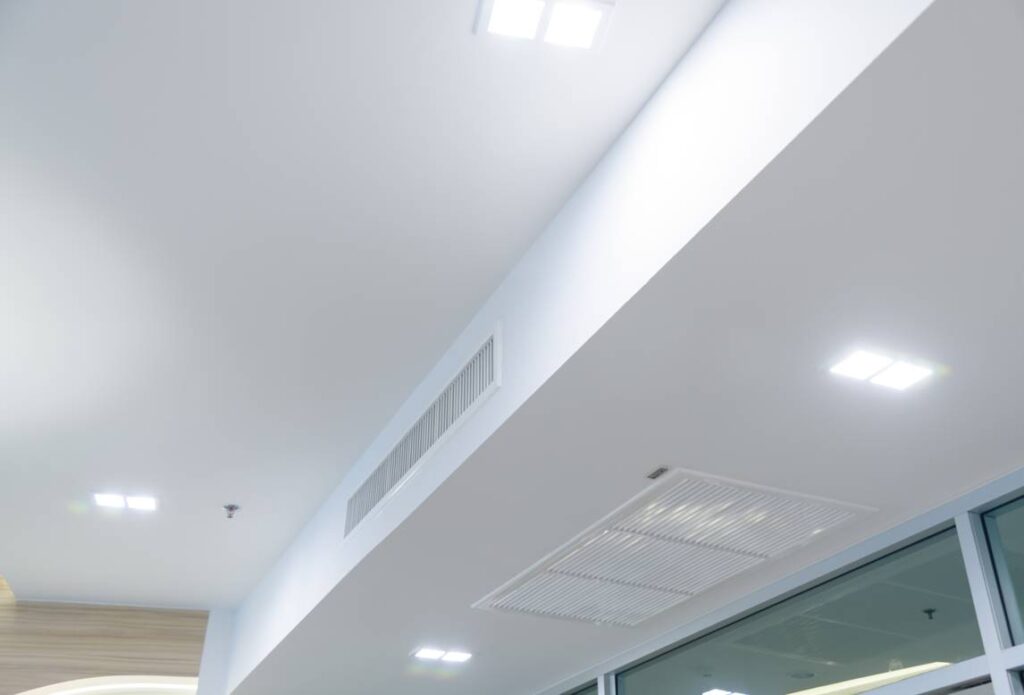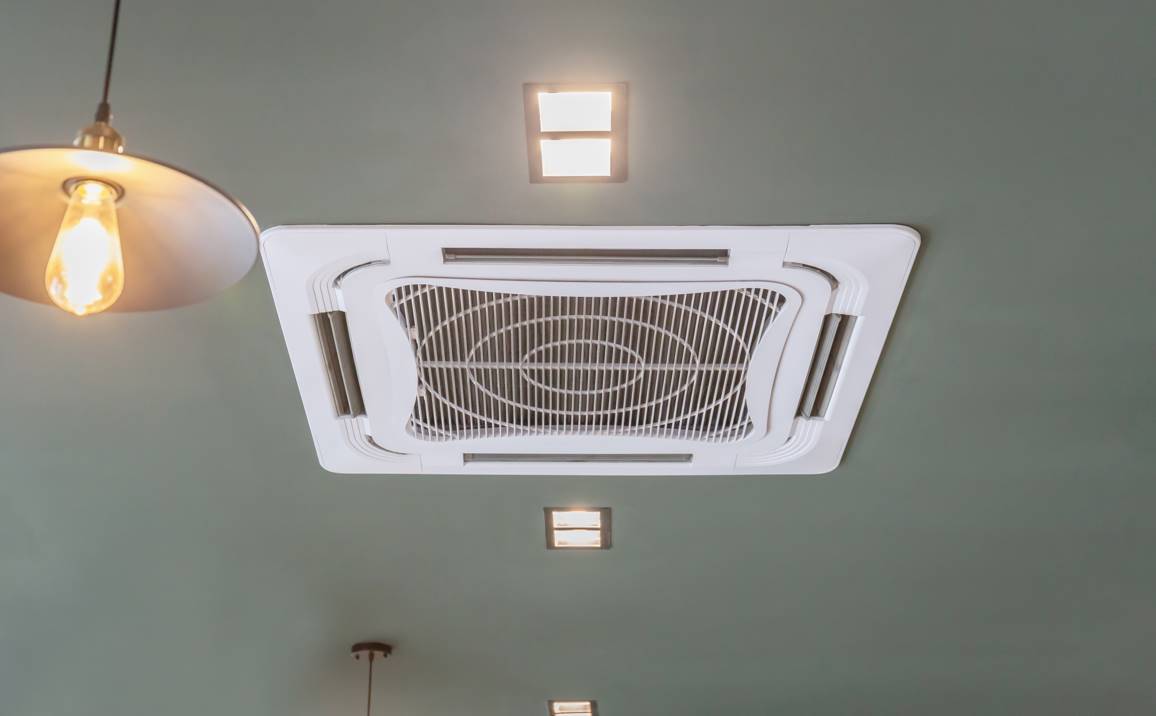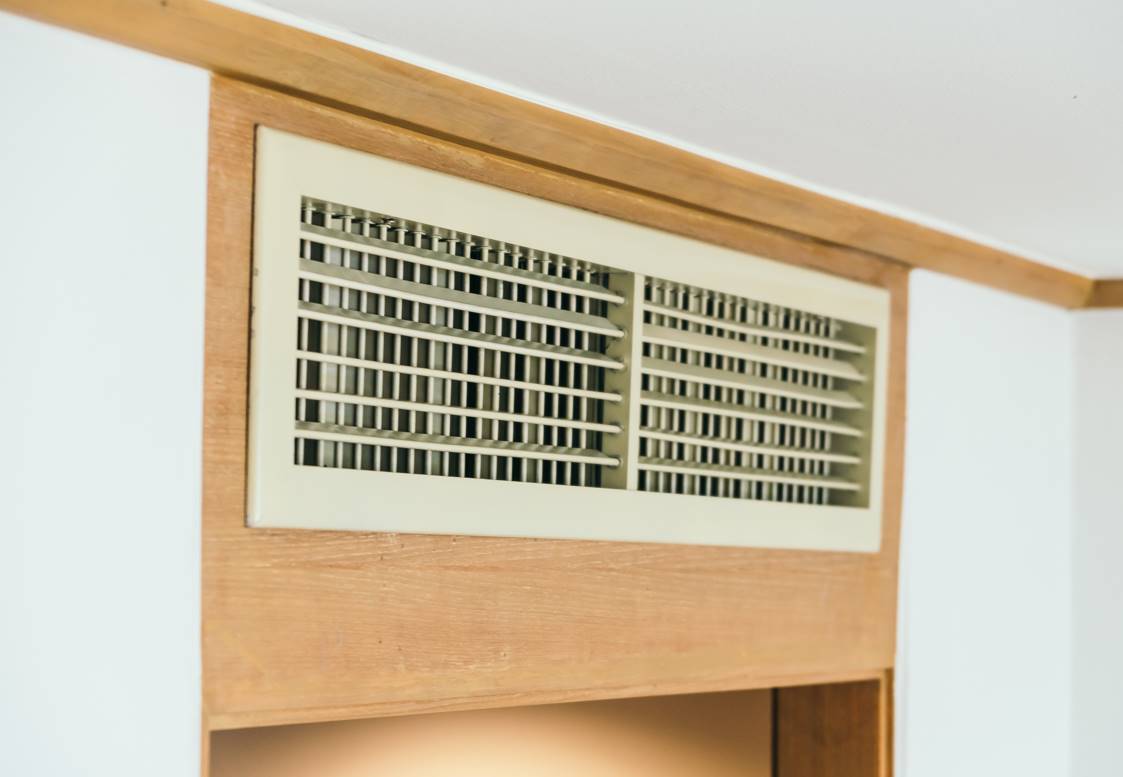Cool air from centralised systems is distributed to individual rooms via ducts and vents. Instead of cooling only one room, you can cool them all. The air ducts in each room feed air into the air handler unit. Passing air is filtered by the system to remove allergens and particles such as lint, dust, pollen, and pet dander that can cause respiratory irritation.
The filtered air is then distributed to the rooms via a second set of ducts. Even the tiniest particles of pollution are too big for these systems to miss. It stands to reason that higher-priced filters will be able to remove more contaminants from the air and thus improve indoor air quality. Central air conditioners have many advantages, one of which is that they provide cool, clean air all the time.
With the help of air conditioning, you can avoid the heat of summer inside. Central air conditioners are the most effective of the various types of AC units. Compressing refrigerant gas and pumping it through a system of coils, this appliance cools the air at central locations throughout your home. The gas acts as a heat sink, drawing warmth from your home's air and releasing it outside. In this article, we will look at eight reasons why central air conditioning is a good investment.
Planning to install a new air conditioning system? Read on for five reasons why installing a central air conditioning system might be a good idea.
Central Air Conditioners: The Different Kinds
Either a split-system or a packaged unit can serve as a central air conditioner.
A heat exchanger, fan, and compressor are all kept in a separate cabinet outside of a split-system central air conditioner. In the indoor cabinet are the exhaust fan and the heat exchanger. The heat exchanger for the kiln or heat pump is often inside the cabinet of a split-system air conditioner. If your residence has a furnace but no AC, a split-system air conditioner may be the most cost-effective way to cool it.
Mounted on the roof or on a concrete block elevated next to the house's foundation, a packaged central air conditioner contains the heat exchanger, compressor, fan, and blower in a single cabinet. This type of air conditioner is also useful for cooling off smaller commercial spaces. Openings in the building's exterior walls or roof are used to connect the supply and return ducts to the packaged air conditioner. A packaged air conditioner can have either a natural gas furnace or electric heating coils installed. This central air conditioner can also serve as a heater, so you won't need an additional heating source.
Benefits of Central Air Conditioning System
Having a central air conditioning system installed in your home or building has many advantages:
Reduced Costs of Energy
Why not take greater control over your home's temperature in this day and age when you can probably already control your lights and maybe even your garage door from an app on your mobile device? You can save money and increase personalisation with a central air conditioning system and a programmable thermostat.
A smart thermostat allows you to adjust the temperature of your home from a mobile device, tablet, or computer. To ensure that your home is comfortably cool when you arrive, you can programme the thermostat to begin the cooling process before you arrive.
Quality of Air Improves
Better air quality can be achieved with a central unit as opposed to a traditional window unit, which is the main benefit of a central cooling system. The air quality is improved because of the central air conditioner, which filters the air circulating through the ducts. Therefore, fewer potentially harmful gases, allergens, and pollutants are breathed in by your loved ones. Humidity levels are reduced as a result of the system's humidity filtration capabilities. This reduces the buildup of mould and pests and makes your home more breathable and comfortable for you and your family.
Central air conditioning is great for cleaning the air of debris like dust, dirt, pet dander, hair, and more, but the filters need to be changed frequently. This improves the effectiveness of your home's cooling system and filtration system. Your central air conditioner's efficiency and lifespan can be negatively impacted if you don't regularly replace the air filter. Thankfully, many up-to-date air conditioners come equipped with indicators that tell you when it's time to swap out the filter.
Stable Temperatures
Central air conditioning is popular because it maintains a constant temperature inside a building throughout the year. A window air conditioner, for instance, can only cool the immediate area around it. That said, a window unit installed in the living room will only be able to cool the living room. A window air conditioner won't be effective in cooling a large, open-concept room.
Central air conditioning is made to cool the entire house at once. No matter how hot it gets outside, the temperature inside the house will remain constant. Not every room needs an ugly window air conditioner, and you won't have to buy them all.
Low Ambient Noise
Common air conditioners make a lot of noise. Let's face it, some are so loud that they keep you up at night and divert your attention from other things you need to do. Because the noisiest part of the system—the condenser unit—is situated outside your home, central air systems operate at a much lower decibel level than window and wall units.
The fact that window units also make a lot of noise is a major drawback. The noise they make is almost distracting and disturbing, so you can tell when they are on and when they are off. Central air conditioners, on the other hand, have advantages such as a quieter operation that is hardly noticeable. The system's initial turn on is audible, but once it begins supplying cool air throughout the house, you won't notice it. The loudest component of a central air conditioner is located outside the home, making it a quiet option inside. The exterior unit is where the condenser and fan are located, and both components generate noise when in use. Because it is external to the building, this component of the AC rarely makes any noticeable noise unless something is wrong with the system.
Friendly Interface
Controlling a central air conditioner is simple. After the system has been installed, you can use a thermostat or remote to set the desired temperature. The ease with which you can operate the air conditioner is determined by the thermostat and unit you select. The most cutting-edge multi-function models still prioritise ease of use. When you leave and return from work, for example, you can set your air conditioner to turn on and off automatically. You can reduce your daily energy consumption by turning on the air conditioning only when you need it. Not even the most cutting-edge window air conditioners offer such luxuries.
Capacity for Heat Generation
There is no need to worry about upkeep for two separate systems because central air conditioners come with all the ductwork your home needs for central heat. In fact, a packaged unit combining an HVAC system and a water heater is available for purchase. This is standard for most modern central air conditioners and will help you save money over time. Like their cooling capacities, the heating capacities of window units are minimal.
Factors of Convenience
Central air conditioning systems save space and are therefore very convenient. A window air conditioner not only obstructs your view, but also lowers the value of your home. The units are large and unsightly, taking up unnecessary room in your house. Covering them up will reduce the efficiency of the unit. Central air conditioning systems still require an exterior component, but the condenser unit can be concealed in the ground and is much more stylish than older models. Covers for air conditioning equipment come in a wide variety of styles, from wooden air conditioner screens to fake vegetation.
Aesthetic Enhancement
The majority of a central air conditioner's parts and machinery are hidden from view, with the exception of the vents themselves. The air handling unit and ductwork are typically hidden away in the attic or a basement. This leaves relatively few visible mechanical components. The aesthetic value of your home, both inside and out, can benefit from this.
How to Choose or Update a Central Air Conditioner?
In terms of energy usage, central air conditioners are superior to individual window or wall units. They are also unobtrusive, silent, and easy to manage. You can save money and resources by decreasing the amount of power your central air conditioner uses and switching to a more energy-efficient model. More than 2,000 kilowatt-hours of electricity are used annually to run air conditioning in a typical American home, leading to the release of 3,500 pounds of carbon dioxide and 31 pounds of sulphur dioxide.
The need for ductwork may be a deciding factor if central air conditioning is something you're thinking about installing in your home.
The most energy-efficient air conditioning units are 30% to 50% more efficient than any of those made in the mid-1970s, but they still provide the same level of cooling comfort. If you replace an air conditioner that is 10 years old with a newer, more energy-efficient model, your cooling costs could go down by 20% to 40%..
Accurate sizing and installation are crucial to an air conditioner's performance. Humidity removal performance declines as unit size increases. On the hottest days, a unit that is too small will fail to provide adequate cooling. Efficiency can be drastically reduced by factors like improper unit placement, inadequate insulation, and faulty ductwork.
Try to find a highly efficient air conditioner when shopping. The SEER is a seasonal measurement of the energy efficiency of central air conditioners (SEER). As a measure of how much energy must be expended in order to produce a given level of cooling, SEER is useful. SEER ratings for many modern systems can reach up to 26.
Get a new, more efficient air conditioner if yours is getting on in years. Central units that have earned the ENERGY STAR® or EnergyGuide labels are about 15 percent more efficient than non-qualified models. On January 1, 2015, new efficiency standards for central air conditioners in residences went into effect. For more information, read the efficiency standards for central air conditioners.
Your central air conditioner does not have to be replaced to meet the standards, and you should be able to find maintenance and repair options for it. A central air conditioning system can "live" for 15–20 years. After the implementation of a new standard, it is common practise for manufacturers to maintain support for previously shipped equipment by keeping spares in stock and honouring maintenance agreements.
Conclusion
Central air conditioners are a popular choice for cooling homes and buildings, as they distribute cool air to individual rooms via ducts and vents. These systems filter the air to remove allergens and particles, ensuring that even the smallest particles are removed. Central air conditioners are the most effective type of AC unit, as they cool the air at central locations throughout the home.
There are two types of central air conditioners: split-system and packaged units. Split-system units have a heat exchanger, fan, and compressor in separate cabinets, while packaged units have a heat exchanger, compressor, fan, and blower in a single cabinet. Packaged units can have natural gas furnace or electric heating coils installed and can also serve as a heater.
Central air conditioning systems offer several benefits, including reduced energy costs, improved air quality, and stable temperatures. They filter the air circulating through ducts, reducing harmful gases, allergens, and pollutants, and reducing humidity levels. However, regular filter replacement is essential to maintain the effectiveness of the cooling system and filtration system.
In summary, central air conditioning is a cost-effective and efficient solution for cooling homes and buildings. It offers several benefits, including reduced energy costs, improved air quality, and stable temperatures.
Central air conditioners offer several advantages over window and wall units, including low ambient noise, a friendly interface, and increased capacity for heat generation. They operate at a lower decibel level, making them quieter and less noticeable than window units. Controlling a central air conditioner is simple with a thermostat or remote, and most modern models prioritize ease of use.
Central air conditioners save space by requiring all the necessary ductwork for central heat generation, which can be found in packaged units. The majority of the parts and machinery are hidden from view, benefiting the aesthetic value of your home.
In terms of energy usage, central air conditioners are superior to individual window or wall units and are unobtrusive, silent, and easy to manage. By decreasing the amount of power your central air conditioner uses and switching to a more energy-efficient model, you can save money and resources. Energy-efficient units are 30% to 50% more efficient than those made in the mid-1970s, but still provide the same level of cooling comfort.
When shopping for a central air conditioner, consider the SEER, a seasonal measurement of the energy efficiency of central air conditioners (SEER), which can reach up to 26. If your current unit is getting old, consider purchasing a new, more efficient one with ENERGY STAR® or EnergyGuide labels.
New efficiency standards for central air conditioners in residences went into effect on January 1, 2015, and they do not need to be replaced. Maintenance and repair options are available, and a central air conditioning system can "live" for 15-20 years.
Content Summary:
- Cool air from centralised systems is distributed to individual rooms via ducts and vents.
- Instead of cooling only one room, you can cool them all.
- The air ducts in each room feed air into the air handler unit.
- Passing air is filtered by the system to remove allergens and particles such as lint, dust, pollen, and pet dander that can cause respiratory irritation.
- The filtered air is then distributed to the rooms via a second set of ducts.
- Even the tiniest particles of pollution are too big for these systems to miss.
- It stands to reason that higher-priced filters will be able to remove more contaminants from the air and thus improve indoor air quality.
- Central air conditioners have many advantages, one of which is that they provide cool, clean air all the time.
- With the help of air conditioning, you can avoid the heat of summer inside.
- Central air conditioners are the most effective of the various types of AC units.
- Compressing refrigerant gas and pumping it through a system of coils, this appliance cools the air at central locations throughout your home.
- The gas acts as a heat sink, drawing warmth from your home's air and releasing it outside.
- In this article, we will look at eight reasons why central air conditioning is a good investment.
- Either a split-system or a packaged unit can serve as a central air conditioner.
- A heat exchanger, fan, and compressor are all kept in a separate cabinet outside of a split-system central air conditioner.
- In the indoor cabinet are the exhaust fan and the heat exchanger.
- The heat exchanger for the kiln or heat pump is often inside the cabinet of a split-system air conditioner.
- If your residence has a furnace but no AC, a split-system air conditioner may be the most cost-effective way to cool it.
- Mounted on the roof or on a concrete block elevated next to the house's foundation, a packaged central air conditioner contains the heat exchanger, compressor, fan, and blower in a single cabinet.
- This type of air conditioner is also useful for cooling off smaller commercial spaces.
- Openings in the building's exterior walls or roof are used to connect the supply and return ducts to the packaged air conditioner.
- A packaged air conditioner can have either a natural gas furnace or electric heating coils installed.
- This central air conditioner can also serve as a heater, so you won't need an additional heating source.
- Why not take greater control over your home's temperature in this day and age when you can probably already control your lights and maybe even your garage door from an app on your mobile device?
- You can save money and increase personalisation with a central air conditioning system and a programmable thermostat.
- A smart thermostat allows you to adjust the temperature of your home from a mobile device, tablet, or computer.
- To ensure that your home is comfortably cool when you arrive, you can programme the thermostat to begin the cooling process before you arrive.
- Better air quality can be achieved with a central unit as opposed to a traditional window unit, which is the main benefit of a central cooling system.
- The air quality is improved because of the central air conditioner, which filters the air circulating through the ducts.
- Therefore, fewer potentially harmful gases, allergens, and pollutants are breathed in by your loved ones.
- Humidity levels are reduced as a result of the system's humidity filtration capabilities.
- This reduces the buildup of mould and pests and makes your home more breathable and comfortable for you and your family.
- Central air conditioning is great for cleaning the air of debris like dust, dirt, pet dander, hair, and more, but the filters need to be changed frequently.
- This improves the effectiveness of your home's cooling system and filtration system.
- Your central air conditioner's efficiency and lifespan can be negatively impacted if you don't regularly replace the air filter.
- Thankfully, many up-to-date air conditioners come equipped with indicators that tell you when it's time to swap out the filter.
- Central air conditioning is popular because it maintains a constant temperature inside a building throughout the year.
- A window air conditioner, for instance, can only cool the immediate area around it.
- That said, a window unit installed in the living room will only be able to cool the living room.
- A window air conditioner won't be effective in cooling a large, open-concept room.
Frequently Asked Questions About Air Condition
A central air conditioner is a cooling system that cools your entire home by distributing conditioned air through ducts and vents. It works by drawing warm air from your home, cooling it through a refrigeration cycle, and then delivering the cooled air back into your living spaces.
Central air conditioners offer several advantages, including:
- Uniform cooling throughout the entire home.
- Improved indoor air quality with the use of air filters.
- Quiet operation as the noisy compressor is located outside.
- Enhanced energy efficiency, especially in larger homes.
- Increased home value due to the presence of a central HVAC system.
Central air conditioners can be highly energy-efficient, especially when they have a high SEER (Seasonal Energy Efficiency Ratio) rating. SEER ratings for central AC units typically range from 13 to 25 or higher, allowing for efficient cooling and potential energy savings.
Yes, central air conditioning systems can often be integrated with smart thermostats and home automation systems. This enables homeowners to control and monitor their cooling system remotely, optimize energy usage, and create customized cooling schedules.
The average lifespan of a central air conditioner is typically around 15 to 20 years with proper maintenance. To extend its lifespan, it's essential to schedule regular professional maintenance, change filters regularly, and address any repairs promptly. Proper installation by qualified technicians also plays a significant role in longevity.



